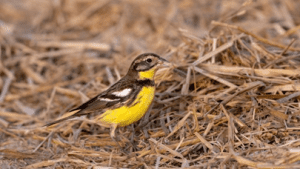TAG: GS 3: ECOLOGY AND ENVIRONMENT
THE CONTEXT: The Nal Sarovar Bird Sanctuary near Ahmedabad, Gujarat, witnessed a historic moment as a Bengaluru couple, on a birding expedition, spotted the critically endangered yellow-breasted bunting.
EXPLANATION:
- This sighting, the second ever recorded in Gujarat and the first in Nal Sarovar, adds a significant feather to the rich avian diversity of this Ramsar site.
- The yellow-breasted bunting is a beautiful passerine bird with striking colors
- Yellow-breasted buntings, typically found in the Himalayan region and East and Central Asia.
- Size: This bunting is relatively large, ranging from 14 to 16 cm (5.5 to 6.3 in) in length and weighing 17 to 26 g (0.6 to 0.9 oz).
- Habitat: These birds prefer agricultural fields, meadows, and wetlands. They were once found in large numbers but are now sadly much less common.
- Distribution: The yellow-breasted bunting breeds across the Boreal and East Palearctic regions. It migrates to wintering grounds in Southeast Asia
- It has been classified as critically endangered by the International Union for Conservation of Nature (IUCN) due to a steep decline in their population.
- The species is not known to winter in Gujarat, making this sighting an extraordinary event.
- The previous sighting of a yellow-breasted bunting in Gujarat occurred in 2019 at Pariege lake.
- This latest observation at Nal Sarovar is only the second in the state, emphasizing the rarity of the species in the region.

Nal Sarovar Bird Sanctuary:
- The Nalsarovar Bird Sanctuary is located in the state of Gujarat, India.
- Specifically, it is situated in the Ahmedabad and Surendranagar districts of Gujarat.
- This sanctuary is approximately 64 kilometers (around 40 miles) to the west of the city of Ahmedabad, which is the largest city in Gujarat.
- The Ramsar Convention designation of Nalsarovar Bird Sanctuary in 2012 recognized its ecological importance as a wetland habitat for birds and other wildlife.
- The designation provides a framework for the conservation and sustainable use of the sanctuary and its surrounding wetlands.
- It also acknowledges the socio-economic importance of the wetlands to the local communities who depend on them for their livelihoods.

